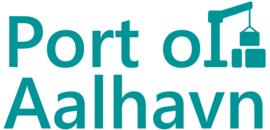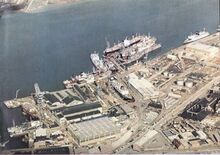Port of Aalhavn: Difference between revisions
(Creation) |
mNo edit summary |
||
| Line 24: | Line 24: | ||
==Geography== | ==Geography== | ||
The Port of Aalhavn is situated in the central part of [[Aalhavn]], near the mouth of the Hinge river. It faces the Bay of Aalhavn which stretches out into the Amber Lake. | |||
==Administration== | ==Administration== | ||
The Port of Aalhavn is managed by [[Fergo Industries#Fergo_InterTrade|Fergo InterTrade]]. The board of directors is headed by the Administrator, appointed by [[Fergo Industries#Fergo_InterTrade|Fergo InterTrade]] and currently Mogens Clemens Klarskov. On the board is also 4 members from the city council, 4 members with a business background and 1 member elected by the employees working in the port area. | |||
==History== | |||
[[File:Aalhavn Port in the 60s.jpg|left|thumb|220px|Aalhavn Port in 1962]] | |||
The Port of Aalhavn has since the 10th century been one of the most important ports in Littland and the Great Lakes region. The small settlement of Aalhavn started out as a fishing village and later housed many ships of the [[Forsvarsstyrken#Navy|Littish Navy]]. Supposedly, Grand Duke Svend the Holy was born in the port of Aalhavn so he could be baptised as soon as he was born. The port helped Aalhavn grow rich during the early Kingdom period due to royal investments to accommodate the growing navy. The port fell into decay during the 17th and 18th centuries however. | |||
A large expansion of the port was done in 1826 and has since served as the major gateway into Littland for most of the outside world. Starting out as simply a naval base and cargo warehouse, it is now the largest port in Littland. The port was modernized in 1916 after the [[Littish Civil War]]. Following expansions in the 1950's and 1960's, the port grew to house 34 berths, including a brand new passenger terminal for the booming tourism industry. During the economic struggles of the 1980's and early 1990's as well as the inflation crisis of the 2000's, the Port of Aalhavn lost its importance as annual cargo tonnage shrunk for years. Government intervention prevented the ports closure in 1987, 1992 and 1996, after which it was put up for auction to any willing companies that would operate it. | |||
Since 1998 the port has been operated by [[Fergo Industries#Fergo_InterTrade|Fergo InterTrade]], a subdivision of [[Fergo Industries]]. In addition to the harbor itself, [[Fergo Industries#Fergo_InterTrade|Fergo InterTrade]] also established an adjoining industrial and service area in 2007, which employs over 25,000 people | [[Fergo Industries]] signed a contract with the government in 1997 for administrative control of the port and surrounding land. Since 1998 the port has been operated by [[Fergo Industries#Fergo_InterTrade|Fergo InterTrade]], a subdivision of [[Fergo Industries]]. In addition to the harbor itself, [[Fergo Industries#Fergo_InterTrade|Fergo InterTrade]] also established an adjoining industrial and service area in 2007, which employs over 25,000 people. | ||
==Terminals== | ==Terminals== | ||
Revision as of 14:20, 16 August 2022
| Port of Aalhavn | |
|---|---|
 Logo since 2006 | |
| Location | |
| Country | |
| Location | Aalhavn |
| UN/LOCODE | LTAAL |
| Details | |
| Opened | 1826 |
| Operated by | Fergo InterTrade |
| Owned by | Public |
| Type of harbor | Deep-water seaport |
| Available berths | 34 |
| Draft depth | 10.5 m |
| Employees | 25,000 |
| Administrator | Mogens Clemens Klarskov |
| Statistics | |
| Vessel arrivals | |
| Annual cargo tonnage | |
| Annual container volume | |
| Annual revenue | |
The Port of Aalhavn deep-sea port located in the city of Aalhavn and is the largest container port in Littland. In 2020, the Port of Aalhavn shipped over 14 million tonnes of cargo and was handling 70% of Littlands total container traffic. Since 1998 Fergo InterTrade has been operating the port.
Geography
The Port of Aalhavn is situated in the central part of Aalhavn, near the mouth of the Hinge river. It faces the Bay of Aalhavn which stretches out into the Amber Lake.
Administration
The Port of Aalhavn is managed by Fergo InterTrade. The board of directors is headed by the Administrator, appointed by Fergo InterTrade and currently Mogens Clemens Klarskov. On the board is also 4 members from the city council, 4 members with a business background and 1 member elected by the employees working in the port area.
History
The Port of Aalhavn has since the 10th century been one of the most important ports in Littland and the Great Lakes region. The small settlement of Aalhavn started out as a fishing village and later housed many ships of the Littish Navy. Supposedly, Grand Duke Svend the Holy was born in the port of Aalhavn so he could be baptised as soon as he was born. The port helped Aalhavn grow rich during the early Kingdom period due to royal investments to accommodate the growing navy. The port fell into decay during the 17th and 18th centuries however.
A large expansion of the port was done in 1826 and has since served as the major gateway into Littland for most of the outside world. Starting out as simply a naval base and cargo warehouse, it is now the largest port in Littland. The port was modernized in 1916 after the Littish Civil War. Following expansions in the 1950's and 1960's, the port grew to house 34 berths, including a brand new passenger terminal for the booming tourism industry. During the economic struggles of the 1980's and early 1990's as well as the inflation crisis of the 2000's, the Port of Aalhavn lost its importance as annual cargo tonnage shrunk for years. Government intervention prevented the ports closure in 1987, 1992 and 1996, after which it was put up for auction to any willing companies that would operate it.
Fergo Industries signed a contract with the government in 1997 for administrative control of the port and surrounding land. Since 1998 the port has been operated by Fergo InterTrade, a subdivision of Fergo Industries. In addition to the harbor itself, Fergo InterTrade also established an adjoining industrial and service area in 2007, which employs over 25,000 people.
Terminals
The port of Aalhavn has 5 major terminals; container, multi, bulk, tanker and passenger terminals.
- The container terminal has 11 large cranes for handling shipping containers in the main terminal, other size cranes are present on other berths.
- The multi terminal handles various cargo such as coal along with major shipments like windmill parts.
- The bulk terminal handles cargo such as gravel, sand, grain and other loose cargo.
- The tanker terminal handles oils, petroleum, chemicals and other luquid cargo, it has adjoining storage facilities.
- The passenger terminal handles passenger arrivals, usually tourists. In 2019, over 4,000,000 people passed through the terminal.

